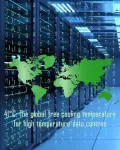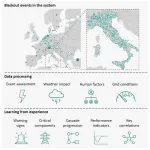(Press-News.org) Quantum mechanics is full of weird phenomena, but perhaps none as weird as the role measurement plays in the theory. Since a measurement tends to destroy the “quantumness” of a system, it seems to be the mysterious link between the quantum and classical world. And in a large system of quantum bits of information, known as “qubits,” the effect of measurements can induce dramatically new behavior, even driving the emergence of entirely new phases of quantum information.
This happens when two competing effects come to a head: interactions and measurement. In a quantum system, when the qubits interact with one another, their information becomes shared nonlocally in an “entangled state.” But if you measure the system, the entanglement is destroyed. The battle between measurement and interactions leads to two distinct phases: one where interactions dominate and entanglement is widespread, and one where measurements dominate, and entanglement is suppressed.
As reported today in the journal Nature, researchers at Google Quantum AI and Stanford University have observed the crossover between these two regimes — known as a “measurement-induced phase transition” — in a system of up to 70 qubits. This is by far the largest system in which measurement-induced effects have been explored. The researchers also saw signatures of a novel form of “quantum teleportation” — in which an unknown quantum state is transferred from one set of qubits to another — that emerges as a result of these measurements. These studies could help inspire new techniques useful for quantum computing.
One can visualize the entanglement in a system of qubits as an intricate web of connections. When we measure an entangled system, the impact it has on the web depends on the strength of the measurement. It could destroy the web completely, or it could snip and prune selected strands of the web, but leave others intact.
To actually see this web of entanglement in an experiment is notoriously challenging. The web itself is invisible, so researchers can only infer its existence by seeing statistical correlations between the measurement outcomes of qubits. Many, many runs of the same experiment are needed to infer the pattern of the web. This and other challenges have plagued past experiments and limited the study of measurement-induced phase transitions to very small system sizes.
To address these challenges, the researchers used a few experimental sleights of hand. First, they rearranged the order of operations so that all the measurements could be made at the end of the experiment, rather than interleaved throughout, thus reducing the complexity of the experiment. Second, they developed a new way to measure certain features of the web with a single “probe” qubit. In this way, they could learn more about the entanglement web from fewer runs of the experiment than had been previously required. Finally, the probe, like all qubits, was susceptible to unwanted noise in the environment. This is normally seen as a bad thing, as noise can disrupt quantum calculations, but the researchers turned this bug into a feature by noting that the probe’s sensitivity to noise depended on the nature of the entanglement web around it. They could therefore use the probe’s noise sensitivity to infer the entanglement of the whole system.
The team first looked at this difference in sensitivity to noise in the two entanglement regimes and found distinctly different behaviors. When measurements dominated over interactions (the “disentangling phase”), the strands of the web remained relatively short. The probe qubit was only sensitive to the noise of its nearest qubits. In contrast, when the measurements were weaker and entanglement was more widespread (the “entangling phase”) the probe was sensitive to noise throughout the entire system. The crossover between these two sharply contrasting behaviors is a signature of the sought-after measurement-induced phase transition.
The team also demonstrated a novel form of quantum teleportation that emerged naturally from the measurements: by measuring all but two distant qubits in a weakly entangled state, stronger entanglement was generated between those two distant qubits. The ability to generate measurement-induced entanglement across long distances enables the teleportation observed in the experiment.
The stability of entanglement against measurements in the entangling phase could inspire new schemes to make quantum computing more robust to noise. The role that measurements play in driving new phases and physical phenomena is also of fundamental interest to physicists. Stanford professor and co-author of the study, Vedika Khemani, says, “Incorporating measurements into dynamics introduces a whole new playground for many-body physics where many fascinating and new types of non-equilibrium phases could be found. We explore a few of these striking and counter-intuitive measurement induced phenomena in this work, but there is much more richness to be discovered in the future.”
END
Google Quantum AI and Stanford University researchers use measurements to generate quantum entanglement and teleportation
Measurements can dramatically change the behavior of a quantum system. Researchers are exploring this behavior and how it can affect the spread and structure of information in a quantum computer
2023-10-18
ELSE PRESS RELEASES FROM THIS DATE:
Cedars-Sinai uses AI to identify people with abnormal heart rhythms
2023-10-18
Investigators from the Smidt Heart Institute at Cedars-Sinai found that an artificial intelligence (AI) algorithm can detect an abnormal heart rhythm in people not yet showing symptoms.
The algorithm, which identified hidden signals in common medical diagnostic testing, may help doctors better prevent strokes and other cardiovascular complications in people with atrial fibrillation—the most common type of heart rhythm disorder.
Previously developed algorithms have been primarily used in white ...
How to build greener data centers? Scientists say crank up the heat
2023-10-18
Colder is not always better for energy-hungry data centers, especially when it comes to their power bills. A new analysis says that keeping the centers at 41°C, or around 105°F, could save up to 56% in cooling costs worldwide. The study, publishing October 10 in the journal Cell Reports Physical Science, proposes new temperature guidelines that may help develop and manage more efficient data centers and IT servers in the future.
“The cooling system accounts for over one-third of the data center’s total energy consumption, so many studies ...
As surging threats teeter electrical power grids, scientists offer insights to make them more resilient
2023-10-18
Power grids—the web of electrical networks that sprawl across countries and continents—are under stress. Extreme weather events and volatile energy demands often push the system to the brink. Although these high-impact events can be very damaging, often overlooked is the impact of minor disruptions that trigger a domino effect throughout the system, according to a study analyzing European power blackouts. The findings, published October 18 in the journal Joule, showed that recovering power within 13 hours can reduce up to ...
Telehealth supports retention in treatment for opioid use disorder
2023-10-18
Starting buprenorphine treatment for opioid use disorder through telehealth was associated with an increased likelihood of staying in treatment longer compared to starting treatment in a non-telehealth setting, according to a new study analyzing Medicaid data from 2019-2020 in Kentucky and Ohio. Published in JAMA Network Open, these findings add to a growing body of evidence demonstrating positive outcomes associated with the use of telemedicine for treatment of opioid use disorder.
In Kentucky, 48% of those who started buprenorphine treatment via telehealth remained in treatment for 90 continuous days, compared ...
Researchers design gene therapy that can effectively target glioblastoma
2023-10-18
In a first-in-human phase 1 trial in 41 patients with recurrent glioblastoma, an oncolytic virus treatment designed by Brigham researchers extended survival, especially among those with pre-existing viral antibodies
Therapy turns ‘immune desert’ into inflammatory cancer-fighting zone
Study demonstrated the safety and preliminary efficacy of a novel gene therapy for glioblastoma
Glioblastoma (GBM), an aggressive brain cancer, is notoriously resistant to treatment, with recurrent GBM associated with survival of less than 10 months. Immunotherapies, ...
From a five-layer graphene sandwich, a rare electronic state emerges
2023-10-18
Ordinary pencil lead holds extraordinary properties when shaved down to layers as thin as an atom. A single, atom-thin sheet of graphite, known as graphene, is just a tiny fraction of the width of a human hair. Under a microscope, the material resembles a chicken-wire of carbon atoms linked in a hexagonal lattice.
Despite its waif-like proportions, scientists have found over the years that graphene is exceptionally strong. And when the material is stacked and twisted in specific contortions, it can take on surprising electronic behavior.
Now, MIT physicists have discovered another surprising property ...
Treatment rates for mental disorders among children and adolescents
2023-10-18
About The Study: The results of this meta-analysis of 40 studies including 310,000 children and adolescents suggest that, in general, the treatment rates for mental disorders among children and adolescents were low, especially for depression and anxiety. Targeted intervention policies and effective measures should be designed and implemented to improve treatment rates of psychiatric disorders among youths.
Authors: Yuanyuan Xiao, Ph.D., of Kunming Medical University in Kunming, Yunnan, China, is the corresponding author.
To access the embargoed study: Visit our For The Media website at this link https://media.jamanetwork.com/
(doi:10.1001/jamanetworkopen.2023.38174)
Editor’s ...
Association of antepartum and postpartum air pollution exposure with postpartum depression in southern California
2023-10-18
About The Study: The findings of this study including 340,000 pregnant women suggest that long-term exposure to antepartum and postpartum air pollution was associated with higher postpartum depression risks. Identifying the modifiable environmental risk factors and developing interventions are important public health issues to improve maternal mental health and alleviate the disease burden of postpartum depression.
Authors: Jun Wu, Ph.D., of the University of California, Irvine, is the corresponding author.
To access the embargoed study: Visit our For The Media website at this link ...
Scientists uncover new way viruses fight back against bacteria
2023-10-18
A microscopic discovery will not only enable scientists to understand the microbial world around us but could also provide a new way to control CRISPR-Cas biotechnologies.
An international team of researchers led by Professor Peter Fineran from the University of Otago and Dr Rafael Pinilla-Redondo from the University of Copenhagen has published a study in the prestigious journal Nature revealing new way viruses suppress the CRISPR-Cas immune systems of bacteria.
Co-first author Dr David Mayo-Muñoz, of the Phage-host interactions (Phi) laboratory in ...
Single vaccine protects against three deadly strains of coronavirus
2023-10-18
DURHAM, N.C. – A vaccine designed to protect against three different deadly coronaviruses shows success in mouse studies, demonstrating the viability of a pan-coronavirus vaccine developed by researchers at the Duke Human Vaccine Institute.
Publishing in the journal Cell Reports, the single nanoparticle vaccine included components of a previous vaccine that was shown to protect mice and primates against multiple variants of SARS-CoV-2, which is the virus that causes COVID-19. In this study, the vaccine protected mice from SARS-CoV-1, another form of SARS coronavirus that can infect humans, and a MERS coronavirus that has led to periodic, deadly outbreaks ...
LAST 30 PRESS RELEASES:
Numbers in our sights affect how we perceive space
SIMJ announces global collaborative book project in commemoration of its 75th anniversary
Air pollution exposure and birth weight
Obstructive sleep apnea risk and mental health conditions among older adults
How talking slows eye movements behind the wheel
The Ceramic Society of Japan’s Oxoate Ceramics Research Association launches new international book project
Heart-brain connection: international study reveals the role of the vagus nerve in keeping the heart young
Researchers identify Rb1 as a predictive biomarker for a new therapeutic strategy in some breast cancers
Survey reveals ethical gaps slowing AI adoption in pediatric surgery
Stimulant ADHD medications work differently than thought
AI overestimates how smart people are, according to HSE economists
HSE researchers create genome-wide map of quadruplexes
Scientists boost cell "powerhouses" to burn more calories
Automatic label checking: The missing step in making reliable medical AI
Low daily alcohol intake linked to 50% heightened mouth cancer risk in India
American Meteorological Society announces Rick Spinrad as 2026 President-Elect
Biomass-based carbon capture spotlighted in newly released global climate webinar recording
Illuminating invisible nano pollutants: advanced bioimaging tracks the full journey of emerging nanoscale contaminants in living systems
How does age affect recovery from spinal cord injury?
Novel AI tool offers prognosis for patients with head and neck cancer
Fathers’ microplastic exposure tied to their children’s metabolic problems
Research validates laboratory model for studying high-grade serous ovarian cancer
SIR 2026 delivers transformative breakthroughs in minimally invasive medicine to improve patient care
Stem Cell Reports most downloaded papers of 2025 highlight the breadth and impact of stem cell research
Oxford-led study estimates NHS spends around 3% of its primary and secondary care budget on the health impacts of heat and cold in England
A researcher’s long quest leads to a smart composite breakthrough
Urban wild bees act as “microbial sensors” of city health.
New study finds where you live affects recovery after a hip fracture
Forecasting the impact of fully automated vehicle adoption on US road traffic injuries
Alcohol-related hospitalizations from 2016 to 2022
[Press-News.org] Google Quantum AI and Stanford University researchers use measurements to generate quantum entanglement and teleportationMeasurements can dramatically change the behavior of a quantum system. Researchers are exploring this behavior and how it can affect the spread and structure of information in a quantum computer



